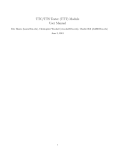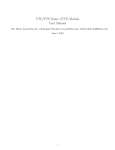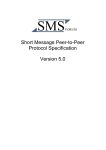Download TTC/TTS Tester (TTT) Module User Manual
Transcript
TTC/TTS Tester (TTT) Module User Manual Eric Hazen [email protected], Christopher Woodall [email protected], Charlie Hill [email protected] May 24, 2013 1 Contents 1 Overview 3 2 Quick Start Guide 4 3 Hardware Description 3.1 Jumpers: Setting the Serial Number 3.2 LED Arrangement . . . . . . . . . . 3.3 NIM Outputs . . . . . . . . . . . . . 3.4 NIM Inputs . . . . . . . . . . . . . . 3.5 LHC Clock Input . . . . . . . . . . . 3.6 Optical Fiber Transceivers . . . . . . 3.6.1 TTC Protocol . . . . . . . . . 3.6.2 SFP Transmitter . . . . . . . 3.6.3 SFP Receiver . . . . . . . . . 3.7 Ethernet Interface . . . . . . . . . . 3.8 Buttons . . . . . . . . . . . . . . . . 3.9 JTAG Port . . . . . . . . . . . . . . 3.10 Legacy TTS LVDS . . . . . . . . . . . . . . . . . . . . . . . . . . . . . . . . . . . . . . . . . . . . . . . . . . . . . . . . . . . . . . . . . . . . . . . . . . . . . . . . . . . . . . . . . . . . . . . . . . . . . . . . . . . . . . . . . . . . . . . . . . . . . . . . . . . . . . . . . . . . . . . . . . . . . . . . . . . . . . . . . . . . . . . . . . . . . . . . . . . . . . . . . . . . . . . . . . . . . . . . . . . . . . . . . . . . . . . . . . . . . . . . . . . . . . . . . . . . . . . . . . . . . . . . . . . . . . . . . . . . . . . . . . . . . . . . . . . . . . . . . . . . . . . . . . . . . . . . . . . . . . . . . . . . . . . . . . . . . . . . . . . . . . . . . . . . . . . . . . . . . . . . . . . . . . . . . . . . . . . . . . . . . . . . . . . . . . . . . . . . . . . . . . . . . . . . . . . . . . . . . . . . . . . . . . . . . . . . . . . . . . . . . . 4 5 5 5 6 6 6 6 7 7 7 8 8 8 4 Software Configuration 8 5 TTT Hardware Verification Procedure 9 6 IPBus Registers 9 2 1 Overview This document describes a module developed at Boston University for use in CMS test stands, especially those based on MicroTCA using the AMC13 module for clock/trigger/DAQ functions. The TTC/TTS Tester Module (TTT) performs the following functions: • Generate simulated TTC signals on two optical fiber outputs, with: – – – – L1A generated periodically or at pseudo-random intervals BC0 with correct spacing (every 3563 clocks) CMS trigger rules observed (programmable) TTS buffer status respected • Receive and process TTS status from AMC13 on optical fiber – Use to modulate trigger rate for internally-generated L1A – Translate to legacy TTS (FMM) output on RJ-45 connector Figure 1: Board Overview with Connectors Illustration 1 shows an overview of the board with connectors and controls. Detailed information is in the Hardware Description section. 3 2 Quick Start Guide Connect a 5V power supply to the power connector (J9). Use the supplied wall transformer (or make your own cable; center terminal is positive). The board should provide the following functions without any software intervention: • The BC0 nim output should provide a 75ns (three clock cycles) wide pulse at the LHC orbit frequency. • Both TTC fiber outputs (transmitter on SFP) should provide a valid TTC bit stream with BC0 encoded every 88µs. • The TTS state received from the AMC13 on the SFP receivers should be output as LVDS on the RJ-45 outputs. • The NIM0 input should generate a L1A on both TTC outputs when a falling edge is seen. In order, to use the board in “receiver” mode, where the Channel A and Channel B SFP connectors output BC0’s and take the received messages and output the L1A’s and BC0’s on the associated NIM outputs, you need to write “0x10” to the TTTControlReg (Address: 0x2). Please, refer to Figure 1 for location. More detailed information can be found in the section “NIM Outputs”. 3 Hardware Description Figure 2 is a basic interface diagram. Figure 2: TTT Block Diagram, with all connectors noted. 4 3.1 Jumpers: Setting the Serial Number The TTT board provides 4 GPIO pins on J14, surrounded by 3.3V (J3) and GND (J17). These 4 GPIO pins go to pins P35, P32, P30 and P39 on the Spartan-6 and are used to set the serial number. Each board is assigned and shipped with a serial number in a 4-bit number space, where each bit of the serial number corresponds to one jumper as indicated in Figure 3. The jumper setting of 0 is reserved for verification mode. Figure 3: Configuration for Settings Jumpers 3.2 LED Arrangement Figure 4 shows the LED arrangement on the front of the TTT. In the default power-on mode of operation the LEDs indicate the following: Figure 4: LED Arrangement and Association • When R0 is solid the DCM is locked and reliable operation can be expected. • R1 indicates that power is being applied to the board. • G0-3 indicate the Serial Number (IP and MAC address) that is currently set. • G4-7 indicate the current TTS state being sent to the Ch. A Fiber. LED Functions inside of the VERIFY firmware are described in the TTT Hardware Verification Procedure section of this document. 3.3 NIM Outputs The NIM outputs can be seen in Figure 1 and are labeled as BC0 (J5), L1A (J4), NIM0 (J18, aux. BC0) and NIM1 (J19, aux. L1A). Modes for NIM outputs can be selected using TTTControlRegister bits 4 to 7. 5 In the default mode (TTTControlRegisters[7..4] (0x2) set to 0x0): • J5 will output BC0 generated internally on the TTT. • J4 will output the L1As being generated by the TTT as setup by the software (see the Software Configuration Section). In the receiver mode (TTTControlRegisters[7..4] (0x2) set to 0x1): • J5 and J4 will output the BC0s and L1As received on Fiber Channel A • J18 and J19 will output the BC0s and L1As received on Fiber Channel B 3.4 NIM Inputs The NIM inputs can be seen in Figure 1 and are labeled NIM IN0 (J20), NIM IN1 (J21), NIM IN2 (J22), and NIM IN3 (J23). The default mode only utilizes NIM IN0 which looks for falling edges and generates a single L1A. Currently no other features or configurations are available for the NIM Inputs, but a configuration register has been made available for future modes (TTTNimInConfig). 3.5 LHC Clock Input This input provides the option to substitute an external clock for the on-board 40.079 MHz crystal. It must be selected by writing FIXME to register FIXME. 3.6 Optical Fiber Transceivers Two SFP cages are provided for optical fiber transceivers. For compatibility wit the TTC system it is recommended to use SFP transcievers compatible with the ATM network protocol. 3.6.1 TTC Protocol The SFP transceivers process biphase-mark encoded bit streams using the protocol specified for the CERN TTC system[?]. The biphase-mark encoding scheme is illustrated in Figure 5. Two bits (called channels A, B) are transmitted each clock cycle. Channel A indicates that an L1A is present, while channel B is used to carry serial data as detailed in Figure 6. Channel B sends 1’s continuously when idle, with a 1→0 transition representing the start of a frame. Various types of frames are documented for the TTC system, but the only type used by this board is the “Broadcast Command” frame. An 8-bit command is transmitted, with the values of the bits shown in Fig. 6. Figure 5: TTC Low-Level Encoding 6 Figure 6: TTC Frame and Broadcast Command Format . 3.6.2 SFP Transmitter ] The transmitters simulate the output of the TTC system. The A channel is used to carry L1A generated internally or received from the NIM0 input. The B channel sends broadcast commands such as those shown in Table 1. BCR/BC0 is sent every orbit (3563 clocks). Other broadcast commands may be sent under software control. Typically to start a data collection run on a test stand the sequence OCR, ECR would be sent with L1A disabled before the start of data taking. Value 00101000 (0x28) 00000010 (0x02) 00000001 (0x01) Acronym OCR ECR BCR Name Orbit Count Reset Event Count Reset (a.k.a. BC0) Bunch Count Reset Table 1: TTC Broadcast Commands Send/Processed by TTT 3.6.3 SFP Receiver The SFP Receiver receives a bitstream from the AMC13 module which carries TTS and local trigger information. The TTC protocol is currently used. A broadcast command is sent periodically by the AMC13 in which the upper 4 bits represent the current TTS state. Channel A is used for local L1A generated in the AMC13. The TTS state is output to the corresponding RJ-45 connector, and also used to modify the operation of the internal L1A generator. If the TTS signals represent any state other than “Ready” the L1A will be halted until the state returns to “Ready”. 3.7 Ethernet Interface The ethernet interface seen in Figure 1 can be used to comunicate between the TTT board and a computer over an 100Mb Full Duplex ethernet connection. All ethernet transactions are handled by the IPBus (v1.3) Firmware Core. For more information on software configuration please see the Software Configuration section. 7 Serial Number 000 001 002 003 004 005 006 007 008 009 010 MAC Address 08-00-30-F3-00-00 08-00-30-F3-00-01 08-00-30-F3-00-02 08-00-30-F3-00-03 08-00-30-F3-00-04 08-00-30-F3-00-05 08-00-30-F3-00-06 08-00-30-F3-00-07 08-00-30-F3-00-08 08-00-30-F3-00-09 08-00-30-F3-00-0a IP Address 192.167.2.32 192.168.2.33 192.168.2.34 192.168.2.35 192.168.2.36 192.168.2.36 192.168.2.38 192.168.2.39 192.168.2.40 192.168.2.41 192.168.2.42 Table 2: IP and MAC Addresses I/P addresses are set by jumper on the PC board as shown in Table 2. For reference on how the jumpers are set up see the section “Jumpers: Setting the Serial Number”. In addition to being used by the software to configure the TTT the ethernet can be used to write to the flash on the TTT. Writing to the flash over IPBus allows for firmware updates to be carried out without a JTAG programming device. Information on how to do this is available in the Software Configuration section. This is only valid for non-volatile programming and the old software version will be overwritten. 3.8 Buttons Two buttons are available on the TTT and are appropriately labeled SW1 is a reset, and SW2 causes an L1A to occur on a falling edge. Both buttons are pulled high (to 3.3V) by default through the Spartan 6’s internal resistors and go low (0V) when pressed. Firmware debouncing is performed on both buttons. 3.9 JTAG Port A JTAG at site J1 is provided as a standard .1 inch header. The signal names are marked (TMS, TDI, etc) on the TTT board. This particular JTAG pinout is meant for use with the Digilent HS-1 JTAG programmer for Xilinx chips. However, another JTAG programmer which is compatible with the Xilinx ISE software, or known to be compatible with Xilinx 6 series chips may also work, but will receive no user support. This port can be used for both volatile (program to FPGA) and non-volatile (program to SPI Flash) programming using the provided “.bit” and “.mcs” files. 3.10 Legacy TTS LVDS In the default mode, set by writing FIXME to the FIXME register, the LVDS channels act as follows: • Channel A and Channel B Tx send the TTS state being received from the AMC13. • All Rx channels are turned off. In legacy mode, set by writing FIXME to the FIXME register, the channels act as follows: • Channel A and Channel B Rx receive the TTS state, SFP (new) TTS messages are ignored • Channel A Tx passes through Channel A Rx, the same goes for Channel B. 4 Software Configuration Charlie. 8 5 TTT Hardware Verification Procedure Blank for now. Will be filled in. 6 IPBus Registers Describe all available registers. Table 3: TTT Register Table Name VERSION Address 0x00000000 Bit Mask 0xffffffff R/W R FirmwareVersionID 0x00000000 0xffffffff R STATUS FLASH MemoryRead FLASH FIFOempty FLASH BUSY FLASH CMD TTTControlReg TTTControlReg ChangeClockSrc 0x00000001 0x00000001 0x00000001 0x00000001 0x00000001 0x00000002 0x00000002 0xffffffff 0x00000004 0x00000002 0x00000001 0xffffffff 0xffffffff 0x00000004 R R R R W R/W R/W TTTControlReg DisableBC0 0x00000002 0x00000008 R/W TTTControlReg NimModes 0x00000002 0x000000f0 R/W TTTActionReg TTTActionReg SendBcastCmd 0x00000003 0x00000003 0xffffffff 0x00000002 R/W R/W TTTBcastCmd 0x00000004 0xffffffff R/W FLASH WBUF FLASH RBUF TTSOrbitLength TTSTrigStart TTSOrbitMax TTSL1ASpacing TTSL1APerOrbit TTSRepeatPeriod TTSFifoByte TTSFifoByte FifoData TTSFifoByte FifoWordCnt TTSFifoByte TriggerCnt TTSFifoByte CounterMux TTSCounterByte 0x00001000 0x00001080 0x00000100 0x00000101 0x00000102 0x00000103 0x00000104 0x00000105 0x00000106 0x00000106 0x00000106 0x00000106 0x00000106 0x00000107 0xffffffff 0xffffffff 0xffffffff 0xffffffff 0xffffffff 0xffffffff 0xffffffff 0xffffffff 0xffffffff 0x0000000f 0x00000030 0x000003c0 0x00000400 0xffffffff R/W R/W R/W R/W R/W R/W R/W R/W R/W R/W R/W R/W R/W R/W TTSRateSet 0x00000108 0xffffffff R/W 9 Description Format: YYYYMMDD where [Y]ear, [M]onth and [D]ay Firmware Version ID (same as VERSION), maintains backwards compatibility. 0x1 read/write Read to get Memory Read. Fifo Empty Status Flash Busy Flash command register Control Reg Write to ’1’ to change clock source to LHC Clock. (FIXME) Write to ’1’ to disable BC0’s on all output streams. Sets NIM modes the controls are as follow. write ’1’ to bit 0 to switch to receiver mode. Action Register Write ’1’ to send Bcast Command, must be manually reset to ’0’. Load Broadcast command into the lower 8 bits, the remaining bits do not matter. Send using TTTActionReg bit 1. Write flash Read flash BX per orbit (nom. 3563) delay to first trigger number of orbits with triggers spacing of L1A within orbit number of L1A per orbit time between repeats in orbits Select byte to read: Fifo data Fifo Word Count Trigger Count Counter Mux Select coutner to read: 0-3 Rule violation 1-4 random threshold Continued on next page Table 3 – continued from previous page Address Bit Mask R/W Description 0x00000109 0xffffffff R/W no more than 1 trig/N Bx 0x0000010a 0xffffffff R/W no more than 2 trig/N Bx 0x0000010b 0xffffffff R/W no more than 3 trig/N Bx 0x0000010c 0xffffffff R/W no more than 4 trig/N Bx 0x0000010d 0xffffffff R/W select orbit signal clock phase 0x0000010e 0xffffffff R/W delay responding to BSY, OFW 0x0000010f 0xffffffff R/W sample TTS when (n and BcN) == 0 TTSTTCBxNum 0x00000110 0xffffffff R/W NIM TTS output at this BcN TTSTTCCmdPrescale 0x00000111 0xffffffff R/W NIM TTS prescale (not impl yet) TTSControlReg 0x00000112 0xffffffff R/W Control Register TTSControlReg enBurt 0x00000112 0x00000001 R/W enable burst (¿1 trigger per orbit) TTSControlReg enRepeats 0x00000112 0x00000002 R/W enable repeats TTSControlReg enBP 0x00000112 0x00000004 R/W enable back pressure TTSControlReg enRandTrig 0x00000112 0x00000008 R/W enable random triggers TTSControlReg disableBlanking 0x00000112 0x00000010 R/W disable blankking of L1A in orbit gap TTSStatusReg 0x00000113 0xffffffff R Status Register TTSStatusReg FifoEmpty 0x00000113 0x00000001 R Fifo Empty TTSStatusReg FifoFull 0x00000113 0x00000002 R Fifo Full TTSActionReg 0x00000114 0xffffffff R/W Action Register TTSActionReg L1Aen 0x00000114 0x00000001 R/W bit 0 - L1A enable TTSActionReg advanceFifo 0x00000114 0x00000002 R/W bit 1 - advance TTS FIFO to next word TTSActionReg captureTrigCnt 0x00000114 0x00000004 R/W bit 2 - capture trigger count for readout TTSActionReg genNewRand 0x00000114 0x00000008 R/W bit 3 - generate new random number TTSActionReg RST 0x00000114 0x00000080 R/W bit 7 - reset TTSDataReg 0x00000115 0xffffffff R Where data selected by TTSFifoByte is presented. Name TTSRule1 TTSRule2 TTSRule3 TTSRule4 TTSClkSel TTSSetBPDelay TTSBPSampleMask 10












